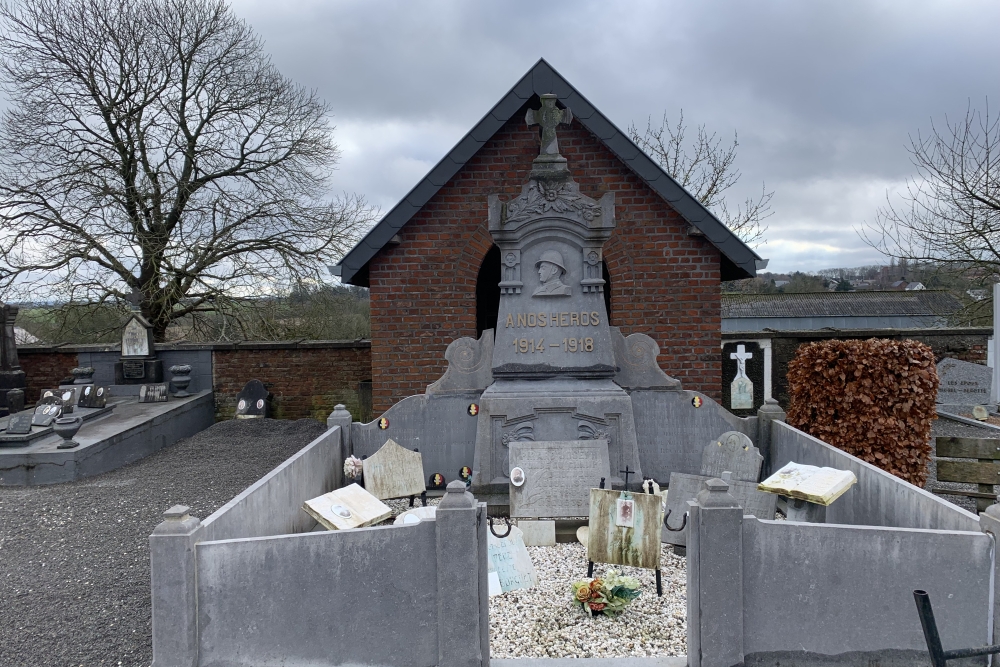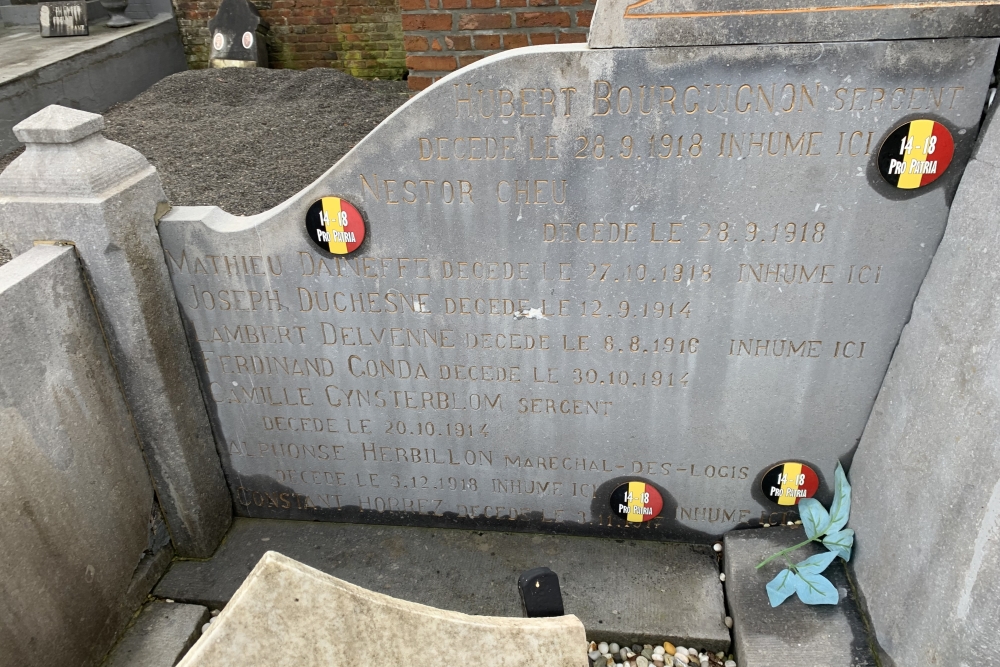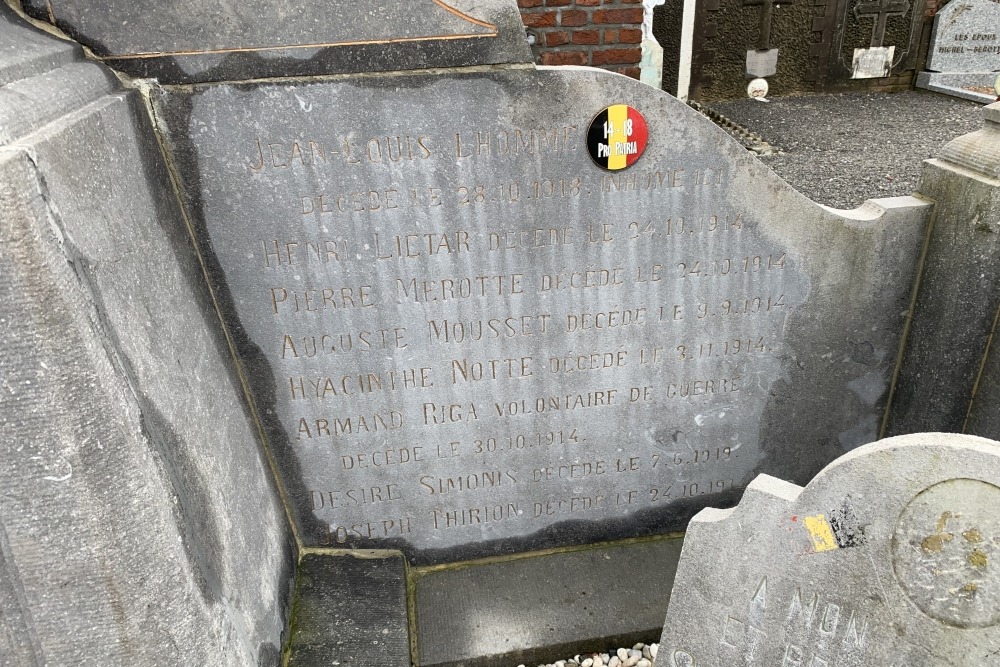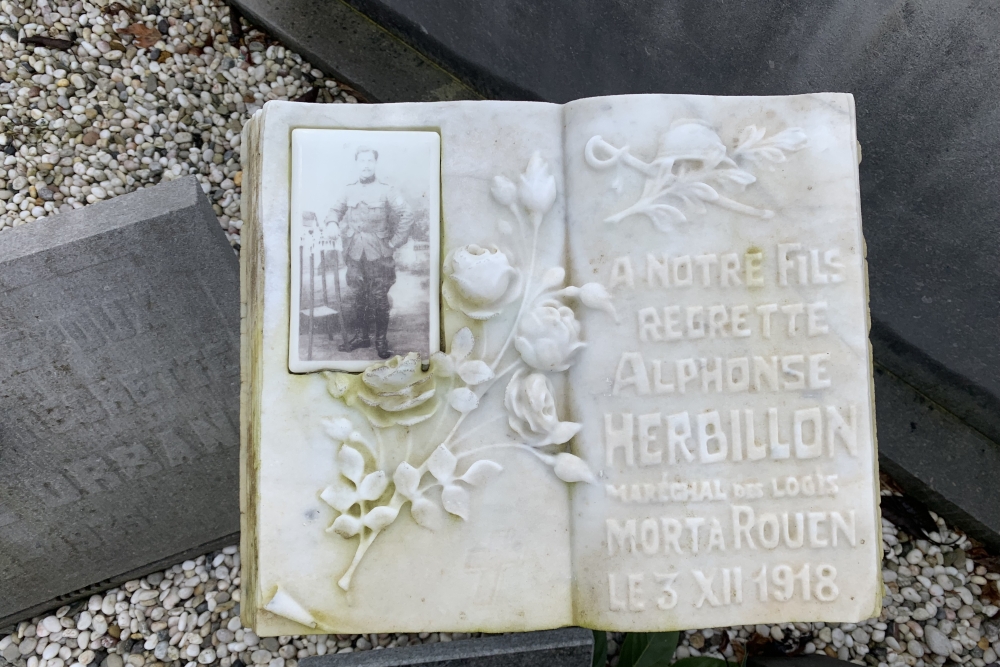Tomb Saint-Georges-sur-Meuse
The monument in the cemetery of Saint-Georges-sur-Meuse commemorates the fallen soldiers coming from the village. It also serves as a gravetomb for six soldiers buried under the monument.
BOURGUIGNON Hubert, age 25, sergeant with the 14th line regiment, killed (bullet through the heart) at Langemark on September 28, 1918.
DAINEFFE Mathieu, age 30, brigadier with the Corps du Transport, died on November 27, 1918, more than one week after the armistice, in the military hospital at Calais (F) from illness (probably Spanish flu).
DELVENNE Lambert, age 23, soldier in the 3rd Division Armée, killed by a bullet in the chest on August 8, 1916 at Kaaskerke.
HERBILLON Alphonse, age 26, sentry in the 8th Artillery Regiment, died of the effects of influenza and pneumonia (probably Spanish flu) on December 3, 1918 (almost a month after the armistice) at the military hospital of Blosseville-Bonsecours (F).
HORREZ Constant, age 28, soldier-driver with the grand parc automobile de réserve (GPAR), killed by shrapnel on November 3, 1917 at Kaaskerke.
L'HOMME Jean-Louis, age 22, soldier with the 19th line regiment, died from shrapnel in his back at Hansbeke on October 28, 1918.
Commemorated are
CHEU Nestor, age 29, soldier with the 14th line regiment, died from the effects of shrapnel at Langemark on September 28, 1918.
DUCHESNE Joseph, age 27, corporal with the 14th linieregiment, killed at Haacht on September 12, 1914.
GONDA Ferdinand, age 21, soldier with the 6th linieregiment, died October 31, 1914 in the field hospital at Veurne from wounds received in battle.
GYNSTERBLOM Camille, age 22, sergeant with the 7th linieregiment, killed October 20, 1914 at Saint-Joris.
LIETAR Henri, age 23, soldier with the 14th line regiment, missing* since October 24, 1914 at Saint-Joris.
MEROTTE Pierre, age 23, soldier with the 14th line regiment, missing* since October 24, 1914 at Saint-Joris.
MOUSSET Auguste, age 24, soldier with the 14th line regiment, killed in action at Haacht on September 29, 1914.
MOTTE Hyacinthe, age 23, soldier with the 6th line regiment, killed in action at Ramskapelle on November 3, 1914.
RIGA Armand, age 26, sergeant with the 3rd Division Armée, killed on October 31, 1914 at Ramskapelle.
SIMONIS Desire, age 26, soldier in the Engineers, died June 7, 1919 ! at Ixelles, from wounds received in battle.
THIRION Joseph, age 27, soldier in the 14th line regiment, killed October 24, 1914 at Saint-Joris.
*missing
That soldiers went missing could have several reasons. In battle, a soldier could be completely blown to pieces by a direct hit of a large caliber grenade and even vaporized by the heat, after which nothing recognizable remained of the soldier. Or in attacks with the flamethrower, a new weapon in the 1st World War. Its use at that time was considered humane in battle. After a full layer of burning oil from a flamethrower could burn a soldier beyond recognition.
Also, as a result of various shell impacts in the trench or a shelter (dugout) in the wall of the trench, a fallen soldier could be buried under earth. Also, several soldiers died (whether or not already wounded) because after they crawled into a shell funnel, then due to excessive rain, they were unable to crawl up the slippery walls of the shell funnel due to the suction effect of the mud combined with the weight of their equipment, and drowned. These shell funnels filled with rain and mud, and one soldier was gone. Missing. Today, soldiers' remains are still found in these types of shell funnels when excavators are used due to civil works around the former battlefield in Belgium and northern France.
Even fallen soldiers left behind in the no man's land fell prey to exploding shells, leaving them mutilated beyond recognition. Or they were eaten by rats, crows or other scavengers, with the eyes usually the first to be picked out of the skull. This in addition to the incoming decomposition of the corpses and the fact that fallen soldiers sometimes remained in the no man's land for up to weeks could cause a soldier to be registered as missing at some point. Identification tags did exist at that time. They were either made of compressed leather (British) or zinc (Germans) but not every soldier wore his plate. Sometimes out of superstition. If I don't wear it nothing will happen to me. Or the plate itself went missing in the chaos of war.
In this context, it should also not be forgotten that countless soldiers still recorded as missing today, rest in an anonymous grave found in all military cemeteries of the Allies and centrals. The corpse was unrecognizable, but buried. The grave inscription was virtually the same in all languages. Here rests a soldier, known only to god.
Do you have more information about this location? Inform us!
Source
- Text: Ed Lewandowski
- Photos: Ed Lewandowski
Nearby
Museum
Point of interest
Monument
- Stele Saint-Georges-sur-Meuse - Saint-Georges-sur-Meuse
- Commemorative Plates War Victims Verlaine - Verlaine
- War Memorial Verlaine - Verlaine
Cemetery
- Belgian Graves Veterans Verlaine - Verlaine
- Belgian War Graves Verlaine - Verlaine
- Belgian War Grave Bodegnée - Bodegnée (Verlaine)








